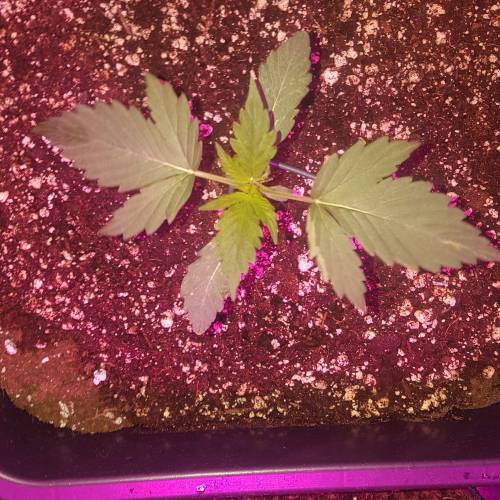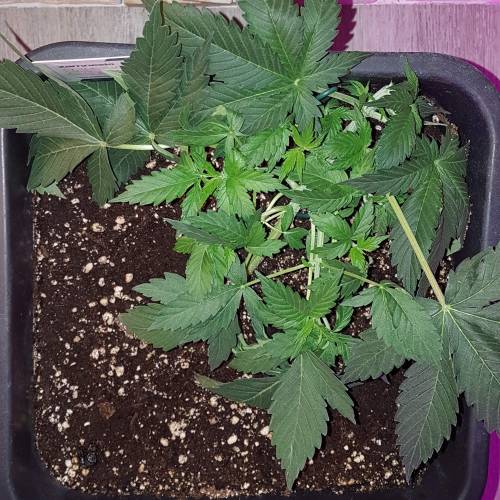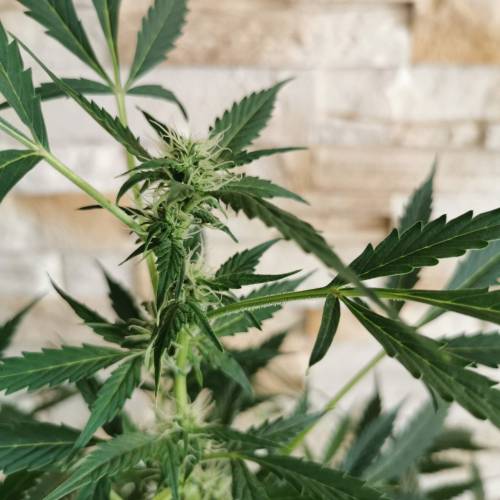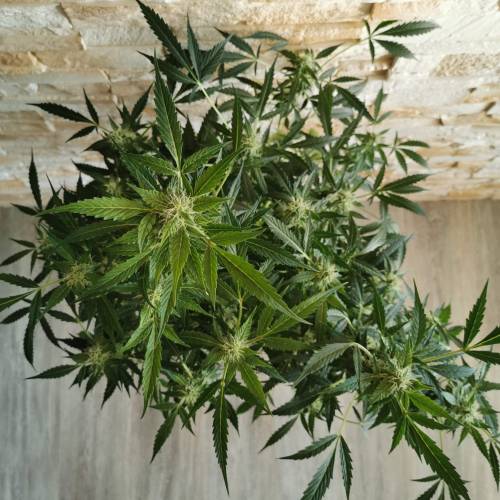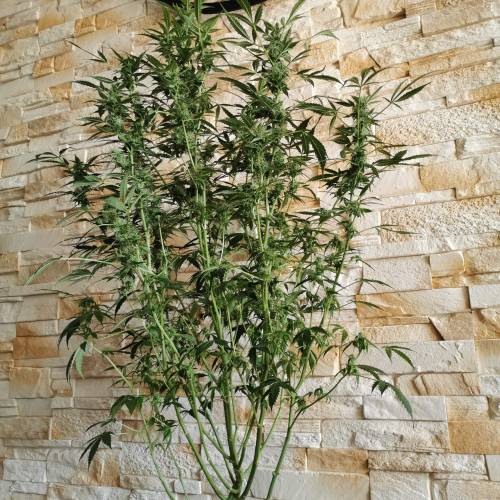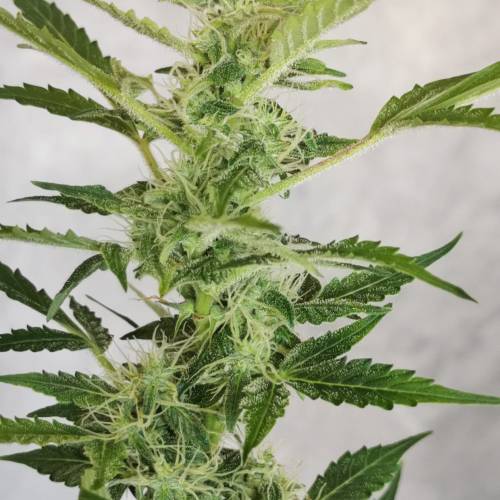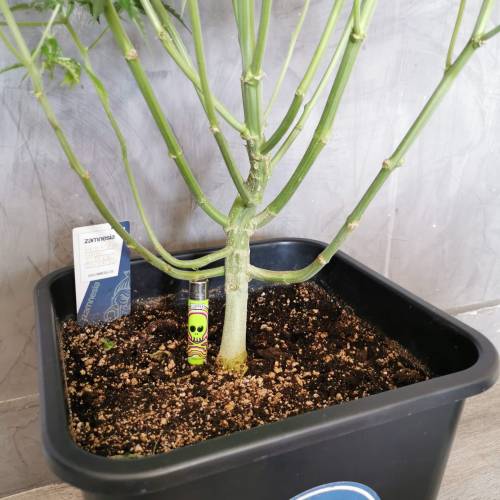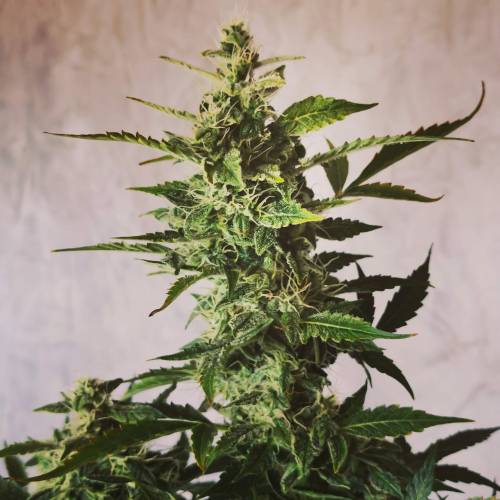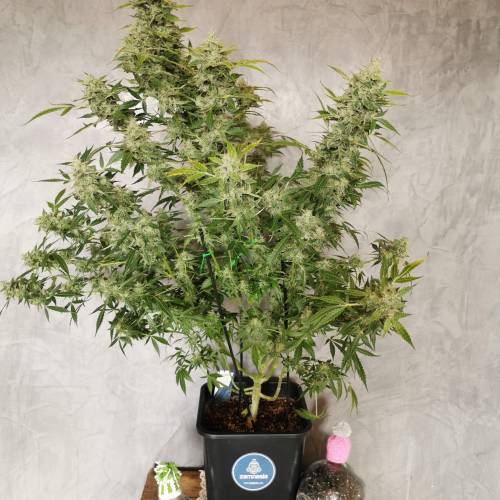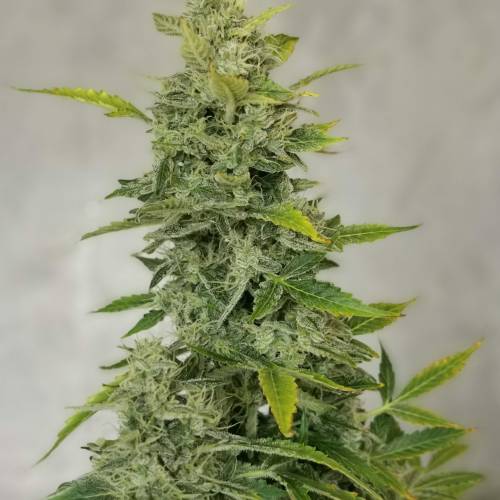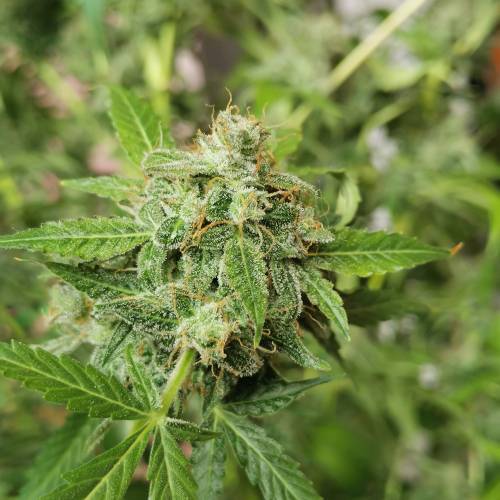The Grow Awards 2026 🏆 















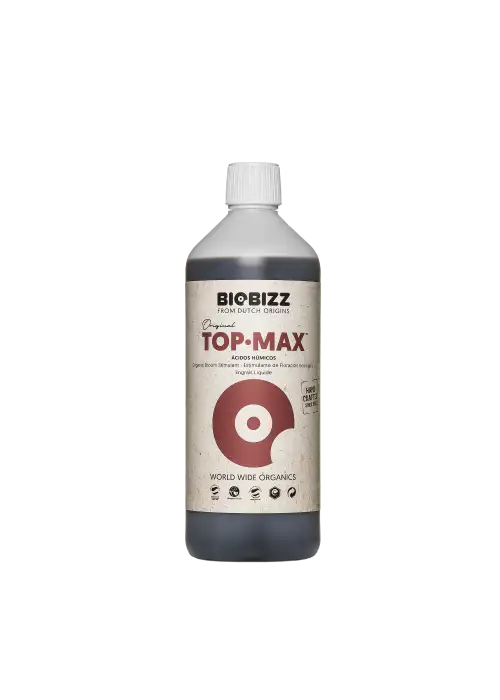







































Zami seed

VEG
Lampwin Light Emitting Diodes/300W
Lampwin

FLO
Lampwin Light Emitting Diodes/300W
Lampwin
Soil
Custom
Indoor
Room Type
LST
weeks 4-5
Defoliation
weeks 7, 10
10 liters
Pot Size
Start at Harvest
1
Week 1. Vegetation6y ago
5 cm
Height
24 hrs
Light Schedule
6.3
pH
70 %
Air Humidity
21 °C
Night Air Temp
10 liters
Pot Size
0.1 liters
Watering Volume
90 cm
Lamp Distance
Nutrients 3

BioBloom
3 mll

BioGrow
3 mll

BioEnhancer
0.6 mll
Master_weeda Bonjour à tous les padawans et maîtres jedis
Tout d'abord merci à Zami de Zamnesia ainsi que greenhouse de me permettre de faire cette culture en m'offrant le feeding greenhouse et des graines
Je rappelle que cultive simultanément 9 pots de 10 et 11 litres dans une box prévu pour 4 et que je n'utilise que le strict minimum du matériel nécessaire à une culture correcte au prix le plus bas possible
MATÉRIEL CONFIGURATION
Box 80×80×160
Lampe led Lampwin 300 watts ×2
Ventilateur à pince 15 watts
Xiaomi Deerma humidificateurs 5L
Hygrometre thermomètre
Extracteur PROFAN 107 m3/h - 100
Prise programmable électronique ×2
1 pot carré noir 10 litres
Green house feeding enhancer
Green house feeding biobloom
Green house feeding biogrow
Substrat biobizz ligthmix
Fil de fer et pince coupante
Microscope
Petite balance de précision
CULTURE ÉTAPE PAR ÉTAPE
J'ai tout dabord fais germé ma graine avec le easy start de Royal queen seed et je suis agréablement surpris car franchement le taux de réussite est très élevé (17 graines sur 19) simple d'utilisation et très efficace.
Une fois la plantule sortie et d'une hauteur de 2 ou 3 centimètres je la prend délicatement et la place directement dans son pot définitif. Je préconise des pots allant entre 10 litres et 15 litres pour des autofloraisons cultivées en intérieur.
Le pot aura été préalablement préparé (video dans diarie) avec 30 grammes d'engrais greenhouse feeding biobloom et 30 grammes de greenhouse feeding biogrow, soit l'équivalent de 3 grammes par litre de substrat.
Je dépose donc la plantule dans son pot définitif je recouvre un peu de avec de la terre je tasse légèrement et j'arrose pour garder le substrat humide pas plus
Je place ma lampe led 300watts à environ 90 centimètres de la plantule avec un cycle de lumière de 24/24 pendant une semaine. Au début de la semaine 2 le cycle de lumière passera en 20/4 grace a un programmateur car c'est pour moi le cycle de lumière qui offre le meilleur rendement pour une autofloraison.
Jour1: léger arrosage
Jour2: léger arrosage
Jour3: la plantule commence à être plus vigoureuse mise en place de la ventilation pour augmenter sa masse racinaire et léger arrosage
Jour4: arrosage avec un litre et demi d'eau ph6.3 à laquelle j'ai ajouté 0.9 gramme de greenhouse feeding enhancer (soit 0.6 gramme par litre d'eau)
Jour5: aucune technique spéciale
Jour6: aucune technique spéciale
Semaine agréablement calme sans problème ni carence apparente
Que la force soit avec vous !
13 likes
comments
Share
2
Week 2. Vegetation6y ago
8 cm
Height
20 hrs
Light Schedule
24 °C
Day Air Temp
6.3
pH
70 %
Air Humidity
21 °C
Night Air Temp
10 liters
Pot Size
0.1 liters
Watering Volume
90 cm
Lamp Distance
Nutrients 3

BioBloom
3 mll

BioGrow
3 mll

BioEnhancer
0.6 mll
Master_weeda Bonjour à tous les padawans et maîtres jedis
Pour cette semaine 2 aucune technique pratiqué, j'ai juste surveillé que l'hygrométrie reste à un taux de 70%. J'ai effectué un léger arrosage jusqu'au jour 10 car le fait que les autofloraisons soient transplantés dans leur pot définitifs augmentent le risque de trop arrosé le substrat. 🤐
Pour palier à ce risque il est préférable d'arroser avec 10 ou 20 centilitres d'eau PH 6.3 durant les 10 premiers jours de la plantule. Au jour 11 j'arrose mon pot normalement avec un quart de son volume en eau (pour un pot de 10 litres 2,5 litres) toujours avec un PH de 6.3, j'ajoute à cette eau 0,6 gramme de greenhouse feeding enhancer par litre d'eau.👍
Enhancer est un mélange d’acides humiques, d’extraits d’algues,
de souches de Trichoderma harzianum et de Bacillus subtilis.
Il augmente la vitalité de la plante, améliore l’absorption des nutriments et améliore la qualité du sol.👍
J'effecturais un arrosage similaire dans 2 semaines
Que la force soit avec vous 💪
14 likes
1 comment
Share
3
Week 3. Vegetation6y ago
12 cm
Height
20 hrs
Light Schedule
23 °C
Day Air Temp
6.3
pH
70 %
Air Humidity
21 °C
Night Air Temp
10 liters
Pot Size
0.1 liters
Watering Volume
90 cm
Lamp Distance
Nutrients 3

BioBloom
3 mll

BioGrow
3 mll

BioEnhancer
0.6 mll
Master_weeda Bonjour à tous les padawans et les maîtres jedis
Pour cette semaine je ne prévoit aucune technique spéciale juste un arrosage. Je profite que cette semaine qui va être relativement calme pour faire un rappel de ce qui est pour moi la meilleure technique pour arroser une autofloraison.
En suivant ces quelques simples conseils vous obtiendrez un résultat optimal tout au long de votre culture :
Le cannabis est une plante qui n’aime pas recevoir un léger arrosage en continu. Il est impératif de l’arroser en grosse quantité, puis d’attendre que la terre soit bien sèche avant d’arroser à nouveau!
Pour calculer la quantité d’eau nécessaire à chaque plante, suivez cette règle :
Le volume d’eau à donner lors de chaque arrosage doit représenter au moins environ un quart du volume du pot !!
Exemples :
pour un pot d’1L, donnez 0,25L d’eau à chaque arrosage pour un pot de 4L, donnez 1L d’eau à chaque arrosage pour un pot de 12L, donnez 3L d’eau à chaque arrosage pour un pot de 30L, donnez 7,5L d’eau à chaque arrosage !etc…
Pour donner un tel volume d’eau, il est souvent nécessaire d’arroser en deux (voir trois) fois, lentement et uniformément sur toute la surface. Disposez de bonnes coupelles sous les pots, celles ci se rempliront d’eau qui remontera dans le pot par capillarité en moins d’une journée. Il est également très important d’utiliser un bon terreau de qualité, avec une bonne capacité de rétention d’eau mais qui assure également un bon drainage (celui ci doit contenir de la perlite, et/ou de la coco, etc..)
Il vous faut alors maintenant attendre quelques jours en sous-pesant régulièrement les pot avec vos bras. Quand ils seront redevenus très légers, vous pourrez arroser à nouveau !!
En effet, comme l’eau pèse beaucoup plus lourd que la terre, un pot gorgé d’eau pèse plusieurs fois le poids d’un pot d’une plante prête à être arrosée. Avec un peu d’entraînement, vous apprendrez donc très rapidement à sous-peser vos pots pour savoir quand une plante a soif.
C’est une technique à la fois très facile et très efficace, et qui peut être appliquée à toutes les plantes en pots !
En arrosant de cette façon, en général vous devrez arroser vos plantes tous les 3 à 6 jours.
Que la force soit avec vous 💪
15 likes
comments
Share
4
Week 4. Vegetation6y ago
17 cm
Height
20 hrs
Light Schedule
23 °C
Day Air Temp
6.3
pH
70 %
Air Humidity
21 °C
Night Air Temp
10 liters
Pot Size
0.1 liters
Watering Volume
90 cm
Lamp Distance
Nutrients 3

BioBloom
3 mll

BioGrow
3 mll

BioEnhancer
0.6 mll
Master_weeda Bonjour à tous les padawans et les maîtres jedis
14 likes
comments
Share
Used techniques
LST
Technique
5
Week 5. Vegetation6y ago
17 cm
Height
20 hrs
Light Schedule
23 °C
Day Air Temp
6.3
pH
70 %
Air Humidity
21 °C
Night Air Temp
10 liters
Pot Size
0.1 liters
Watering Volume
90 cm
Lamp Distance
Nutrients 4

Top-Max
0.5 mll

BioBloom
3 mll

BioGrow
3 mll
Master_weeda Day33 arrosage
Day36 arrosage avec 2 litres d'eau ph6.3 à laquelle j'ajoute 3 grammes de feeding biobloom greenhouse en griffant la terre
je surveille comme à mon habitude hygrométrie et arrosage. Je peaufine mon LST en stressant ma plante le moins possible. Je combine mon LST avec un pincage d'Apex cela me permettra d'avoir une canopé plus homogène donc une meilleure pénétration lumineuse et par conséquent un meilleur rendement.
Petit rappel sur le pincage d'Apex:
Le pinçage des plantes de cannabis
Proche de la taille d’apex sur le principe, cette technique possède cependant plusieurs avantages, le principal étant de conserver le gros bud central de la plante, d’une production et qualité maximale.
Pinçage des plantes de cannabis
Le pinçage d’apex (tête de la plante) consiste simplement à pincer délicatement la tige du dernier étage de la plante, entre le pouce et l’index, jusqu’à sentir la fibre s’écraser sous les doigts avec un petit bruit critch caractéristique. Si l’espace disponible sur la tige du dernier étage ne permet pas d’y placer confortablement ses doigts, il faudra plutôt pincer l’étage du dessous.
Le pinçage ralentira fortement la croissance verticale de la plante, tout en stimulant le développement des branches secondaires, donnant ainsi à la plante une forme de buisson.
La plante mettra quelques jours à réparer ce pinçage, formant un nœud à cet endroit, et poursuivra ensuite sa croissance de façon normale. Le pinçage peut alors être répété si nécessaire, sur l’étage suivant nouvellement formé, ainsi que sur les éventuelles branches secondaires qui pourraient dépasser l’apex.
Le pinçage est donc une excellente technique pour avoir une belle canopée uniforme de type marée verte. En pinçant régulièrement l’apex des plus grandes plantes de votre espace, durant la croissance et en début de floraison (stretch), vous obtiendrez ainsi facilement des plantes de hauteur homogène en pleine floraison, ce qui facilitera la culture et augmentera la production finale, surtout si vous cultivez simultanément de multiples variétés de marijuana.
Avec un peu d’habitude le pinçage pourra être réalisé aussi rapidement qu’efficacement. En cas de pinçage trop violent qui se traduirait par un apex arraché, cela produira simplement les mêmes résultats qu’une taille classique de l’apex, ce qui ne sera donc pas dramatique.
Que la force soit avec vous💪
16 likes
2 comments
Share
Used techniques
LST
Technique
6
Week 6. Flowering6y ago
15 cm
Height
20 hrs
Light Schedule
23 °C
Day Air Temp
6.3
pH
70 %
Air Humidity
21 °C
Night Air Temp
10 liters
Pot Size
0.1 liters
Watering Volume
60 cm
Lamp Distance
Nutrients 4

Top-Max
0.5 mll

BioBloom
3 mll

BioGrow
3 mll
Master_weeda Hello to all padawans and jedis masters
Week 6 this magnificent plant enters bloom and portends an exceptional stretch for an autoflowering.
(Stretch explanations more)
EXPOSURE TO LIGHT
One of the main culprits in abnormal stretching of cannabis plants is the lack of light. Plants that are too far from an adequate light source will respond by accelerating stem growth in order to get closer to the lamp themselves. Especially when there are many other plants. A lack of lighting can easily cause overcrowding in a growing chamber, reducing the steady progression of your crop and the distance ratio between your bulbs and your plants.
To address this problem, be sure to provide enough light to your plants to prevent stem growth. At the same time, you should not position your lights too close to your plants either since this would also result in an over-stretching of the stems and in some cases, the loss of your crop.
In addition to the distance between the light source and the plant, the type of light you will use also affects the size of the stretching of your crop. The orange and red lights encourage stretching and result in thinner, larger stems. And conversely, blue light stimulates a growth of thicker stems and a smaller size. When a species is ready to enter the vegetative phase and undergo its most drastic stretching period, metal halide lamps can be used to deter far too long stems.
THE HEAT
Heat is another essential element that can determine the stretch size of your plants during vegetation. Temperatures above 27 degrees push the stems to lengthen more and more and will propel the potential of sativas to push as high as possible. Heat lamps that are positioned too close to plants create an intolerable environment that will grow large, soft plants that will potentially wobble until they fall and lose flowers in its fall.
OTHER CAUSES OF STRETCHING
There are multiple variables that can lead to the stretching of plants beyond what could normally be expected of the plant. Environmental stressors resulting from transplantation (when a plant passes from one pot to another) can cause the plant to return to shock. This will eventually trigger a reaction causing a stretch. Cannabis plants that are not grown in decent conditions or do not receive enough nutrients will respond in a variety of ways and this includes stretching.
Crops that are not spaced far enough apart are likely to stretch to sting the light to other plants. Due to extreme proximity, the plants will fight among themselves to reach the light, forcing them to expand as much as possible throughout the crop.
HOW TO CONTROL STRETCHING DURING FLOWERING
Stretching during flowering, you guessed it, takes place when you move your plants from the vegetation stage to the flowering stage. This is a completely normal reaction, as your plants are preparing to bear the weight of their heads.
Stretching of a plant at the beginning of flowering varies widely; some plants can double in height while others grow only a few centimetres. There are, however, two main variables that can give you at least an idea of how your plants are stretching during flowering, and how much. Here are these two variables:
Variety: Genetics has the greatest impact on the size of your plant. In general, sativa varieties stretch more than indicas and tend to develop long, slender stems.
Light: Some lights, such as HPS, are more likely to encourage stretching. In addition, great distances between your canopy and your lights will cause the plants to stretch as they try to get closer to the light source.
Stretching during flowering usually lasts the first two weeks of the phase. To minimize stretching, keep your lights between 10 (for CFL) and 30 centimetres (for HID) of your canopy. Finally, choose indica varieties if you have a smaller growing space.
HOW TO AVOID STRETCHING
In many cases, you can expect your cannabis plants to stretch during the flowering phase. Keeping that in mind helps to make a plan in case your species ends up growing much more than you could have imagined. If the information is available, get information on the standard size of your species and compare it to the size of your growing space taking into account the necessary distances between the bulbs and the plants.
TRAFFIC
While outdoor crop operations benefit from natural air to naturally limit stretching, indoor crops must assume the maintenance of air circulation within a confined space. Basic ventilation is enough to help the cannabis stems strengthen and become thicker rather than too high. In this way, the plants continue to grow vigorously without reaching heights and at the same time, your tolerance ceiling.
MANUAL INTERVENTION
For growers who want to get their hands dirty, there are physical procedures that can be done to reduce stretching. Similar to the natural effect that the wind has on cannabis plants, manually bending the leaves and stems will cause tiny cracks in the plant's tissues that will cause the plant to focus on regenerating its wounds instead of its vertical growth.
THE TOPPING
Topping is a form of manual intervention on cannabis to influence its performance, shape or size. In essence, topping is a process in which a new node is cut, growing from the plant to reduce its size and create a "v"-shaped notch that will eventually form two heads. Topping may be an effective measure to combat stretching, but it is important not to do so when the flowering phase begins.
In most cases, an abnormal stretch of cannabis plants will not completely destroy your crop. In fact, stretching can indeed help increase your performance. For growers with a growing operation large enough to contain tall plants, stretching can increase the total yield of a species with more vertical space for head formation. In both cases, stretching can easily be planned in advance and there are multiple solutions to help you with this problem which is all too common.
14 likes
1 comment
Share
7
Week 7. Flowering6y ago
28 cm
Height
20 hrs
Light Schedule
23 °C
Day Air Temp
6.3
pH
70 %
Air Humidity
21 °C
Night Air Temp
10 liters
Pot Size
0.1 liters
Watering Volume
60 cm
Lamp Distance
Nutrients 4

Top-Max
0.5 mll

BioBloom
3 mll

BioGrow
3 mll
Master_weeda Bonjour à tous les padawans et maîtres jedis
Stretch 13cms defolliation jour42
Jour45 rien juste le kiff
J'effectue une légère defolliation pour permettre une meilleure pénétration lumineuse aux apexs du bas.
Quesque la defolliation ?
LES CULTIVATEURS AMATEURS, PRENEZ GARDE, MAIS NE PRENEZ PAS PEUR
La défoliation consiste à retirer les feuilles des plants de cannabis en intérieur afin d'accroître le rendementfinal. Le cultivateur amateur doit faire preuve de vigilance lorsqu'il commence à appliquer cette technique de taille. Malgré le débat sans fin entre ceux qui prônent cette technique et ceux qui la dénigre, il n'y aucune raison pour qu'un amateur ne s'y essaie pas afin de voir si ça lui convient ou non.
COMMENT DÉFOLIER
Que vous tailliez les feuilles ou les branches des plants de cannabis, il vaut mieux utiliser un sécateur stérile qui est confortable en main. Arracher des feuilles à la main manque de finesse et engendre souvent par accident, l'arrachement des couches d'une tige en plus de la feuille. L'objectif principal de la défoliation est de permettre une meilleure pénétration de la lumière et de promouvoir la production de plus grosses têtes. Les feuilles éventails qui font de l'ombre doivent être retirées. Tailler la tige principale et/ou les pousses secondaires n'est pas de la défoliation.
La règle d'or lorsque vous donnez à vos plantes un rafraîchissement est de commencer avec les feuilles nourricières les plus grandes et les plus larges, en taillant du bas vers le haut. Il est important de retirer les feuilles stratégiquement et non pas au hasard. Pensez également qu'il vous faut limiter votre rafraîchissement à approximativement 10 à 20 % des feuilles totales de votre pied. Il est très facile de s'emporter durant la taille et de se retrouver avec des plantes chauves. Un excès de taille de feuilles empêchera la photosynthèse et paralysera vos plants.
QUAND FAUT-IL DÉFOLIER
Il est assez rare d'appliquer la défoliation comme seule technique pour obtenir un fort rendement. La taille des feuilles est généralement associée à d'autres méthodes de tailles et de palissage pour un meilleur rendement telles que le topping ou étêtage, le FIMming, le LST, le manifolding, le supercropping et le ScrOG. Les cultivateurs utilisant la méthode ScrOG auront besoin de retirer toutes les croissances inférieures ainsi que les feuilles et les tiges se trouvant sous le filet.
Les plants de cannabis peuvent être défoliés dès lors qu'ils sont passés de la phase de plantule vers la phase de croissance végétative. Cependant, il est recommandé aux cultivateurs amateurs de laisser aux plantes 1 à 2 semaines de croissance végétative avant de s'attaquer à la défoliation de celles-ci. De plus, certaines variétés sont plus sensibles à la taille que d'autres et de ce fait, seront plus stressées par la taille des feuilles. Surveillez minutieusement le comportement de vos plants après la taille. Une période de convalescence de minimum 3 à 7 jours avant de recommencer la défoliation est fortement recommandée pour éviter trop de stress aux plants. Les cultivateurs peuvent également défolier pendant la phase de floraison, ce qui permettra à l'énergie de la plante d'être concentrée vers la production de têtes tout en limitant l'ombre et l'excès d'humidité. Néanmoins, il est important de ne pas défolier trop tard sous peine de simplement blesser ses plants inutilement.
LES AVANTAGES DE LA DÉFOLIATION
Évidemment, l'avantage numéro un de la défoliation, c'est l'augmentation du potentiel de rendement de cette technique de taille pour tous types de cannabis allant de la photopériode aux variétés autofloraison. Ce n'est pas un secret que les fleurs qui reçoivent plus de lumières deviennent plus grandes et larges que celles dissimulées dans l'ombre des feuilles. De plus, retirer les feuilles intérieures des plants touffus aide à prévenir toutes menaces de moisissure. Les plants très feuillus avec un feuillage intérieur dense produiront une quantité importante de têtes pop-corn. Dans le pire des cas, les branches de têtes et les têtes qui sont denses succomberont au pourrissement.
Si vous observez des gouttes d'eau se former sur la surface des feuilles, il est grand temps de penser à faire de la défoliation. Libérer la zone inférieure et médiane des feuilles est un excellent moyen d'améliorer la circulation de l'air.
LES DÉSAVANTAGES DE LA DÉFOLIATION
Les plants de cannabis en intérieur bénéficient de la défoliation pour deux raisons. La première est parce qu'ils reçoivent la lumière d'une source stationnaire au-dessus d'eux, et la deuxième est parce que les conditions environnementales sont contrôlées par le cultivateur et non Mère Nature. Les plants d'extérieurs eux, n'y gagnent pas beaucoup, car les cas échéants se vérifient pour eux. Le soleil traverse le ciel, illuminant sur sa route, différentes portions de la plante de son lever à son coucher.
Les cultivateurs en extérieur n'ont pas besoin de manipuler les plantes afin qu'elles se développent en adoptant une structure plate puisque le soleil est infiniment plus puissant que n'importe quelle lampe de culture et qui plus est, il est toujours en mouvement. Tailler les feuilles des plants extérieurs les rend également plus vulnérables aux conditions humides et brise leurs barrières naturelles contres les nuisibles.
De nombreux cultivateurs d'intérieur peuvent, et malheureusement, c'est souvent le cas, réduire le rendement final à cause d'une défoliation faite au mauvais moment et/ou excessive. Tailler les plantules n'est pas conseillé et engendre souvent des plants nains. Scalper les plants matures est encore pire, et au lieu d'obtenir de longues branches de têtes, vous obtiendrez probablement encore moins de fleurs. De même, tailler des plants malades ou en mauvaise santé à n'importe quelle période de la croissance risque de paralyser la croissance plutôt que d'encourager la formation de fleurs denses.
Que la force soit avec vous 💪
12 likes
comments
Share
Used techniques
Defoliation
Technique
8
Week 8. Flowering6y ago
40 cm
Height
20 hrs
Light Schedule
23 °C
Day Air Temp
6.3
pH
50 %
Air Humidity
21 °C
Night Air Temp
10 liters
Pot Size
0.1 liters
Watering Volume
60 cm
Lamp Distance
Nutrients 4

Top-Max
0.5 mll

BioBloom
3 mll

BioGrow
3 mll
Master_weeda Stretch 12 centimètres
Jour52 arrosage avec 2 litres d'eau ph6 6.3
14 likes
comments
Share
9
Week 9. Flowering6y ago
61 cm
Height
20 hrs
Light Schedule
23 °C
Day Air Temp
6.3
pH
Weak
Smell
50 %
Air Humidity
21 °C
Night Air Temp
10 liters
Pot Size
0.1 liters
Watering Volume
60 cm
Lamp Distance
Nutrients 4

Top-Max
4 mll

BioBloom
3 mll

BioGrow
3 mll
Master_weeda + 21 centimètres Jour56
Jour56 arrosage avec deux litres d'eau ph6.3 ajout de 5 grammes de greenhouse feeding biobloom en griffant la terre
Jour59 arrosage avec deux litres d'eau ph6.3à laquelle j'ajoute 4ml par litre d'eau de topmax biobizz
14 likes
comments
Share
10
Week 10. Flowering6y ago
84 cm
Height
20 hrs
Light Schedule
23 °C
Day Air Temp
6.3
pH
Weak
Smell
50 %
Air Humidity
21 °C
Night Air Temp
10 liters
Pot Size
0.1 liters
Watering Volume
60 cm
Lamp Distance
Nutrients 4

Top-Max
4 mll

BioBloom
3 mll

BioGrow
3 mll
Master_weeda Stretch 23centimètres
Jour63 arrosage avec deux litres d'eau ph6.3
Jour66 defolliation et arrosage avec deux litres d'eau ph6.3 à laquelle j'ajoute un gramme par litre d'eau de feeding enhancer greenhouse
12 likes
1 comment
Share
Used techniques
Defoliation
Technique
11
Week 11. Flowering6y ago
94 cm
Height
20 hrs
Light Schedule
23 °C
Day Air Temp
6.3
pH
Weak
Smell
50 %
Air Humidity
21 °C
Night Air Temp
10 liters
Pot Size
0.1 liters
Watering Volume
60 cm
Lamp Distance
Nutrients 4

Top-Max
4 mll

BioBloom
3 mll

BioGrow
3 mll
Master_weeda Plus 10 centimètres !
Jour70 arrosage avec 2 litres d'eau ph6. 3
Jour72 arrosage avec 2 litres d'eau ph6. 3
Jour75 arrosage avec 2 litres d'eau ph6. 3
16 likes
comments
Share
12
Week 12. Flowering6y ago
99 cm
Height
20 hrs
Light Schedule
23 °C
Day Air Temp
6.3
pH
Weak
Smell
50 %
Air Humidity
21 °C
Night Air Temp
10 liters
Pot Size
0.1 liters
Watering Volume
60 cm
Lamp Distance
Nutrients 4

Top-Max
4 mll

BioBloom
3 mll

BioGrow
3 mll
Master_weeda Bonjour à tous les padawans et maîtres jedis
Stretch plus 5 centimètres (mais où va t'elle s'arrêter ?)
Jour77 arrosage avec 2 litres d'eau ph6. 3
Jour80 defoliation pour que les buds puissent prendre la lumière, j'ajoute en griffant la terre 3 grammes de feeding biobloom @greenhouse et j'arrose avec 2 litres d'eau ph6.3
15 likes
2 comments
Share
13
Week 13. Flowering6y ago
99 cm
Height
20 hrs
Light Schedule
23 °C
Day Air Temp
6.3
pH
Strong
Smell
50 %
Air Humidity
21 °C
Night Air Temp
10 liters
Pot Size
0.1 liters
Watering Volume
60 cm
Lamp Distance
Nutrients 4

Top-Max
4 mll

BioBloom
3 mll

BioGrow
3 mll
Master_weeda Bonjour à tous les padawans et maîtres jedis
Jour84 arrosage avec 2 litres d'eau ph6.3
Jour87 arrosage avec 2, 5 litres d'eau ph6.3
Jour89 arrosage avec 2,5 litres d'eau ph6.3
14 likes
2 comments
Share
14
Week 14. Flowering6y ago
99 cm
Height
20 hrs
Light Schedule
23 °C
Day Air Temp
6.3
pH
Strong
Smell
50 %
Air Humidity
21 °C
Night Air Temp
10 liters
Pot Size
0.1 liters
Watering Volume
60 cm
Lamp Distance
Nutrients 4

Top-Max
4 mll

BioBloom
3 mll

BioGrow
3 mll
Master_weeda Bonjour à tous les padawans et maîtres jedis
Jour91 arrosage avec 2 litres d'eau ph6.3
jour93 arrosage avec 2 litres d'eau ph6.3
Jour95 arrosage avec 2 litres d'eau ph6.3
Jour97 arrosage avec 2 litres d'eau ph6.3
12 likes
comments
Share
15
Week 15. Flowering6y ago
102 cm
Height
20 hrs
Light Schedule
23 °C
Day Air Temp
6.3
pH
Strong
Smell
50 %
Air Humidity
21 °C
Night Air Temp
10 liters
Pot Size
0.1 liters
Watering Volume
23.62 cm
Lamp Distance
Nutrients 4

Top-Max
4 mll

BioBloom
3 mll

BioGrow
3 mll
Master_weeda Bonjour à tous les padawans et maîtres jedis
Jour98 arrosage avec 2 litres d'eau ph6.3
Jour101 arrosage avec 2, 5litres d'eau ph6.3
Jour103 arrosage avec 2 litres d'eau ph6.3
14 likes
comments
Share
16
Week 16. Flowering6y ago
102 cm
Height
20 hrs
Light Schedule
23 °C
Day Air Temp
6.3
pH
Strong
Smell
50 %
Air Humidity
21 °C
Night Air Temp
10 liters
Pot Size
1 liters
Watering Volume
45 cm
Lamp Distance
Nutrients 4

Top-Max
4 mll

BioBloom
3 mll

BioGrow
3 mll
Master_weeda Bonjour à tous les padawans et maîtres jedis
Jour106 arrosage avec 2 litres d'eau ph6.3
Debut de sénescence au jour 106 les trichomes commencent à ambrés. Elle devrait être prête pour lundi soit pour le jour 113 ou peut être 116 tout dépend de l'évolution des trichomes
16 likes
3 comments
Share
16
Week 16. Harvest6y ago
Happy Harvest Day!

10/10
Rated
Bonjour à tous les padawans et maîtres jedis
Commentaires à venir..
Show more
Translate
Spent 113 days
Ger Veg Flo Har
563 g
Bud wet weight per plant
107 g
Bud dry weight per plant
1
Plants
0.8 m²
Grow Room size
Easy
Difficulty

Creative, Energetic, Happy
Positive effects

Dry eyes, Dry mouth
Negative effects
Height
Day air temperature
Air humidity
PH
Light schedule
Night air temperature
Pot size
Lamp distance
15 likes
7 comments
Share
Equipment Reviews

the end.
Enjoying this diary? Follow for more updates!
Prefer the old Diary view?
Go back to the old Diary view


































